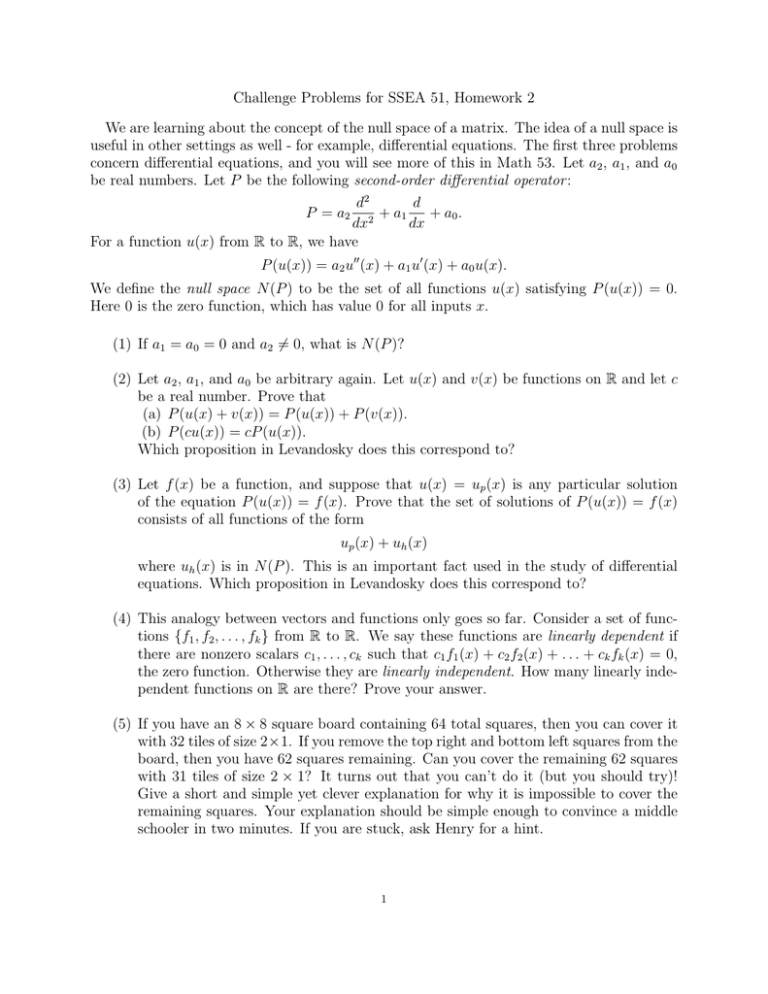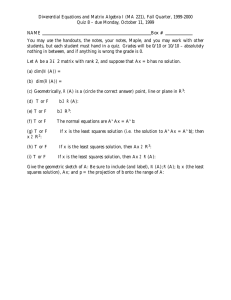Challenge Problems for SSEA 51, Homework 2
advertisement

Challenge Problems for SSEA 51, Homework 2
We are learning about the concept of the null space of a matrix. The idea of a null space is
useful in other settings as well - for example, differential equations. The first three problems
concern differential equations, and you will see more of this in Math 53. Let a2 , a1 , and a0
be real numbers. Let P be the following second-order differential operator :
d2
d
+ a0 .
P = a2 2 + a1
dx
dx
For a function u(x) from R to R, we have
P (u(x)) = a2 u00 (x) + a1 u0 (x) + a0 u(x).
We define the null space N (P ) to be the set of all functions u(x) satisfying P (u(x)) = 0.
Here 0 is the zero function, which has value 0 for all inputs x.
(1) If a1 = a0 = 0 and a2 6= 0, what is N (P )?
(2) Let a2 , a1 , and a0 be arbitrary again. Let u(x) and v(x) be functions on R and let c
be a real number. Prove that
(a) P (u(x) + v(x)) = P (u(x)) + P (v(x)).
(b) P (cu(x)) = cP (u(x)).
Which proposition in Levandosky does this correspond to?
(3) Let f (x) be a function, and suppose that u(x) = up (x) is any particular solution
of the equation P (u(x)) = f (x). Prove that the set of solutions of P (u(x)) = f (x)
consists of all functions of the form
up (x) + uh (x)
where uh (x) is in N (P ). This is an important fact used in the study of differential
equations. Which proposition in Levandosky does this correspond to?
(4) This analogy between vectors and functions only goes so far. Consider a set of functions {f1 , f2 , . . . , fk } from R to R. We say these functions are linearly dependent if
there are nonzero scalars c1 , . . . , ck such that c1 f1 (x) + c2 f2 (x) + . . . + ck fk (x) = 0,
the zero function. Otherwise they are linearly independent. How many linearly independent functions on R are there? Prove your answer.
(5) If you have an 8 × 8 square board containing 64 total squares, then you can cover it
with 32 tiles of size 2×1. If you remove the top right and bottom left squares from the
board, then you have 62 squares remaining. Can you cover the remaining 62 squares
with 31 tiles of size 2 × 1? It turns out that you can’t do it (but you should try)!
Give a short and simple yet clever explanation for why it is impossible to cover the
remaining squares. Your explanation should be simple enough to convince a middle
schooler in two minutes. If you are stuck, ask Henry for a hint.
1



